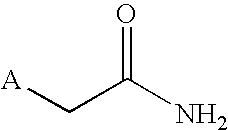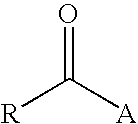Method of treating arrhythmias
a technology of arrhythmia and treatment method, which is applied in the direction of cardiovascular disorders, drug compositions, organic chemistry, etc., can solve the problems of irregular rhythms (arrhythmias) being minor inconveniences, affecting the ability of the ventricle to eject blood, and affecting the effect of heart pumping efficiency,
- Summary
- Abstract
- Description
- Claims
- Application Information
AI Technical Summary
Problems solved by technology
Method used
Image
Examples
example 2
[0207] A tablet formula is prepared using the ingredients below:
6 INGREDIENT (mg / TABLET) Active Ingredient 25.0 Cellulose, microcrystalline 200.0 Colloidal silicon dioxide 10.0 Stearic acid 5.0
[0208] The components are blended and compressed to form tablets.
example 3
[0209] A dry powder inhaler formulation is prepared containing the following components:
7 Ingredient Weight % Active Ingredient 5 Lactose 95
[0210] The active ingredient is mixed with the lactose and the mixture is added to a dry powder inhaling appliance.
example 4
[0211] Tablets, each containing 30 mg of active ingredient, are prepared as follows:
[0212] Quantity
8 Ingredient (mg / tablet) Active Ingredient 30.0 mg Starch 45.0 mg Microcrystalline cellulose 35.0 mg Polyvinylpyrrolidone 4.0 mg (as 10% solution in sterile water) Sodium carboxymethyl starch 4.5 mg Magnesium stearate 0.5 mg Talc 1.0 mg Total 120 mg
[0213] The active ingredient, starch and cellulose are passed through a No. 20 mesh U.S. sieve and mixed thoroughly. The solution of polyvinylpyrrolidone is mixed with the resultant powders, which are then passed through a 16 mesh U.S. sieve. The granules so produced are dried at 50.degree. C. to 60.degree. C. and passed through a 16 mesh U.S. sieve. The sodium carboxymethyl starch, magnesium stearate, and talc, previously passed through a No. 30 mesh U.S. sieve, are then added to the granules which, after mixing, are compressed on a tablet machine to yield tablets each weighing 120 mg.
PUM
| Property | Measurement | Unit |
|---|---|---|
| concentrations | aaaaa | aaaaa |
| voltages | aaaaa | aaaaa |
| voltages | aaaaa | aaaaa |
Abstract
Description
Claims
Application Information
 Login to View More
Login to View More - R&D
- Intellectual Property
- Life Sciences
- Materials
- Tech Scout
- Unparalleled Data Quality
- Higher Quality Content
- 60% Fewer Hallucinations
Browse by: Latest US Patents, China's latest patents, Technical Efficacy Thesaurus, Application Domain, Technology Topic, Popular Technical Reports.
© 2025 PatSnap. All rights reserved.Legal|Privacy policy|Modern Slavery Act Transparency Statement|Sitemap|About US| Contact US: help@patsnap.com



